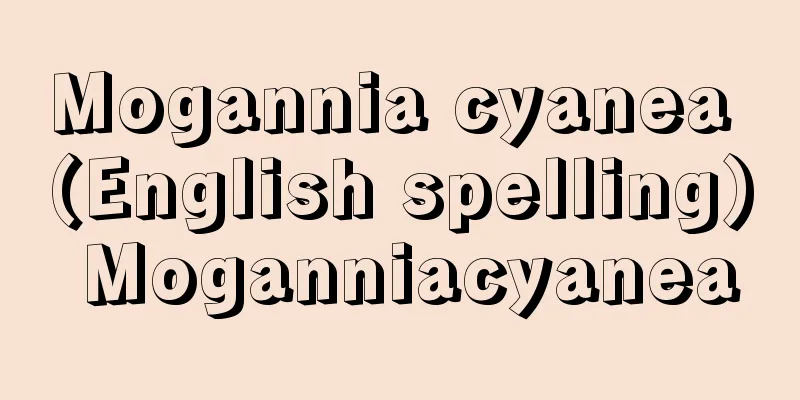Kohata

|
A place name in the northern part of Uji City, Kyoto Prefecture. It is also called "Kowata." It has been a leading Uji tea producing area since the early modern period. In ancient times, Kowata was a place name that referred to a wide area from Uji County to Kii County in Yamashiro Province, but in the late Heian period it came to refer only to Uji County, and in the early modern period, Kowata Village in the same county was established and the area was fixed. In the Kojiki, there is a story that Emperor Ojin met Miyanushiyakahaehime, the daughter of Wani no Hifure no Oomi, in Kowata Village and made her his empress. In the Manyoshu, it appears as "Kihata" and "Tsuyoda," and from the content of the poems, it is assumed that this place was a key point on the Hokuriku road at the time, from the crossing of the Uji River to Ousakayama in Omi, and that there was a post horse facility there. In a lost passage from the Yamashiro no Kuni Fudoki, a "Kohata Shrine" appears, which is said to be a shrine listed in the Engishiki (Engishiki for the Imperial Court). There are ancient tombs from the 5th and 6th centuries scattered around the area, but the area was later designated as the burial grounds of the Fujiwara clan by the regent Fujiwara no Mototsune, and the children of the Fujiwara clan who became regents, regents, and empresses were buried there. In 1005, Fujiwara no Michinaga built Kohata Sammai-do (Jomyoji) as a place of rest for the Fujiwara clan. Later, the Kyogokuden Hall, a villa for Fujiwara no Morozane, and the Matsuden Hall, a villa for Fujiwara no Motofusa, were also built here, and the area, along with the nearby Goka no Sho area (the Tomioka Hall, a villa for the regent and empress), had a deep connection to the Fujiwara clan. The area around the Fujiwara clan graveyard is now a cemetery, under the name of Uji Mausoleum, and is managed by the Imperial Household Agency. Source : Heibonsha Encyclopedia About MyPedia Information |
|
京都府宇治市北部の地名。〈こわた〉ともいう。近世以来の有数の宇治茶産地。古代の木幡は山城国宇治郡から紀伊郡にかけての広域をさす地名であったが,平安時代後期には宇治郡内だけをさすようになり,近世には同郡木幡村が成立して範域が固定した。《古事記》に応神天皇が〈木幡村〉で〈丸邇之比布礼能意富美(わにのひふれのおほみ)〉の娘〈宮主矢河枝比売(みやぬしやかはえひめ)〉に会い,后としたという話がみえる。《万葉集》には〈木旗〉〈強田〉の表記で登場し,詠歌の内容などから,当地が宇治川渡河点から近江逢坂(おうさか)山へ至る当時の北陸道の要衝で,駅馬の施設があったことが推定されている。《山城国風土記》逸文には〈木幡の社〉がみえ,式内社〈許波多(こはた)神社〉とされる。当地には5〜6世紀の古墳が点在するが,その一帯をのち関白藤原基経(もとつね)が一門の墓所と定め,以降摂政・関白や入内(じゅだい)した藤原氏の子女が葬られ,1005年には藤原道長が菩提(ぼだい)所として木幡三昧堂(浄妙寺)を建立している。のち藤原師実(もろざね)の別業(なりどころ)京極殿,藤原基房(もとふさ)の別業松殿も造営されており,近隣の五ヶ庄(ごかのしょう)一帯(摂関家領冨家殿)とともに藤原氏に縁の深い地であった。〈木幡里〉や浄妙寺があったという〈御倉(みくら)山〉は歌枕。藤原氏の墓域一帯は近代に陵墓地とされ,宇治陵の名称で宮内庁の管理下にある。
出典 株式会社平凡社百科事典マイペディアについて 情報 |
Recommend
Euskadi
…The unified name Basque originated from the Roma...
Willibrord
...It has been famous for its mineral springs sin...
Puppet government
A government that is manipulated by another count...
oxidation potential
…the equilibrium electrode potential of an oxidat...
Kongoshoji Temple
A Rinzai sect Nanzenji temple located on the summi...
Epiphronitis
...Interspecific hybridization is rare, but inter...
Rengeji Temple Death Register - Rengeji Temple Death Register
A register of the deaths owned by Rengeji Temple i...
Kunisaki Peninsula
Located in the northeastern part of Oita Prefectu...
Dingcun ruins
A group of Middle Paleolithic ruins near Dingcun,...
Stick binding - Stick binding
(1) The title of a Kyogen piece. Written as "...
Multimedia - Multimedia (English spelling)
A system that converts information such as animat...
Ichigami Festival - Ichigami Festival
〘Noun〙 A festival for the city gods that is held a...
Anzac Day
Strictly speaking, it refers to the soldiers who ...
Arab Empire - Arab Teikoku (English spelling) Arab
This refers to the period of the Orthodox Caliphat...
Tolbert, WR
...He also mediated between rival factions in the...









![New Ireland [island] - New Ireland](/upload/images/67cc71dc8090e.webp)